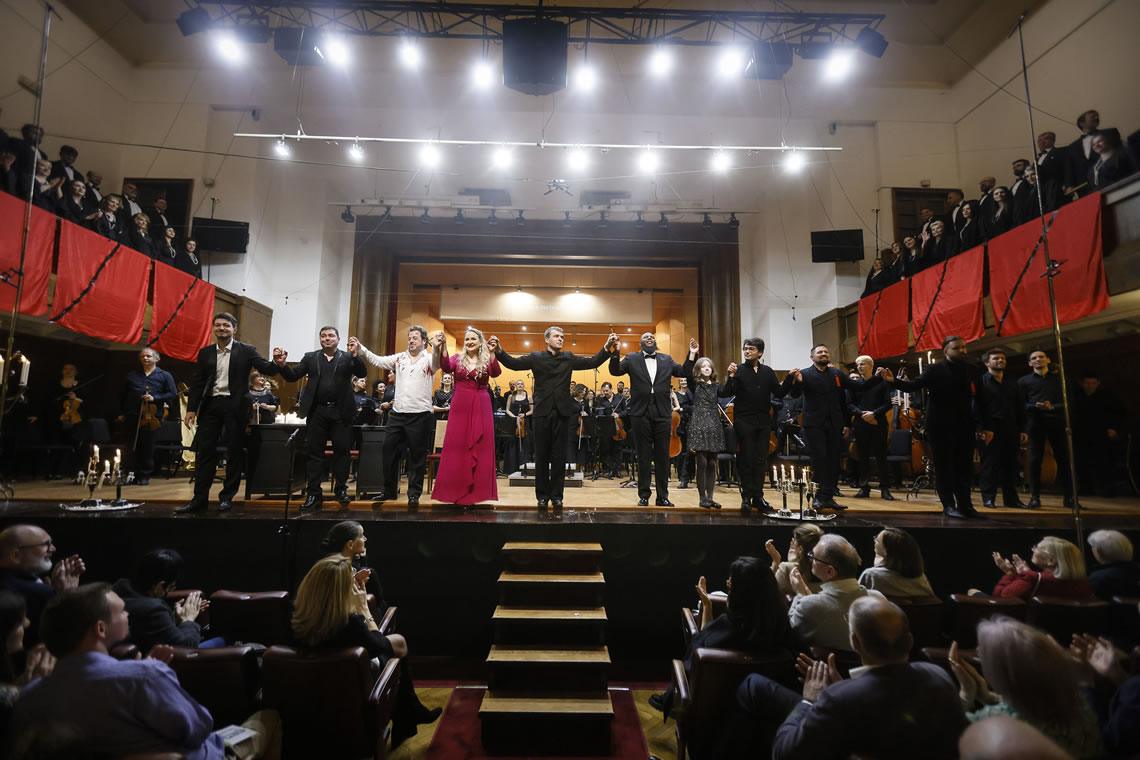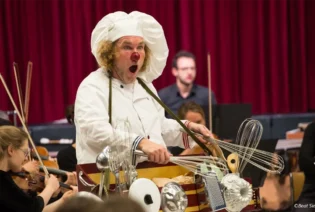
Strong criticism of the Philharmonic performance of the opera Tosca
The most exclusive event of the season, the famous opera Tosca, produced and performed by the Belgrade Philharmonic, with chief conductor Gabriel Feltz, was performed on February 24 at Kolarc Concert Hall. The interest in this unusual event and the Philharmonic’s foray into the opera genre was exceptional, as evidenced by the sold-out tickets days in advance, as well as numerous praises after the performance. With the grandiose undertaking contributed by director Aleksandar Nikolić, the Belgrade Philharmonic realized a special stage spectacle, turning the Great Hall of the Kolarac endowment into an extravagant opera scene. The audience had the opportunity to hear a great international singers – soprano Elizabeth Taiga in the role of Tosca, tenor Eduardo Aladren as Mario Cavaradossi and baritone Mandlu Mndebele in the role of Baron Scarpia.
We present to you excerpts of criticism from domestic media:
Philharmonic Tosca was one of the most wonderful performanse of the season, which we will remeber for a log time:
„…Intense, powerful, passionate and deep – this is how the first opera ever performed in the Kolarac hall sounded on Friday. It may seem strange, impossible even, to stage a veristic opera, such as Giacomo Puccini’s Tosca, in a concert hall, all together with the symphony orchestra, choir and soloists. Even if it hadn’t been announced, one could have easily guessed who was behind it all – no one other than the Belgrade Philharmonic Orchestra and its chief conductor Gabriel Feltz.
The Belgrade Philharmonic Orchestra responded to a new task in the best possible way. In times when innovative performances of operas in domestic opera halls are scarce, the Orchestra, not typically having this genre in its repertoire at all, still rises to the challenge and achieves a real triumph. It was truly a pleasure to enjoy in such a complex score of Giacomo Puccini’s Tosca in its spectacular interpretation. From the powerful orchestral opening, through the romantic arias and the dramatic plot, all the way to the tragic end – the orchestra sounded harmonious in both expression and color. The dynamic and tonal highlighting of the themes, associated with the characters of Scarpia, Tosca and Mario Cavaradossi, further enriched the overall impression. The duets of the romantic couple from the first act were particularly delightful, where Tosca’s bursts of jealousy were depicted by the dramatic and nervous tone of the orchestra, while Cavaradossi’s soothing attempts and declarations of affection were accompanied by beautiful lyrics. Also, Scarpia’s evil intentions to steal Tosca were accompanied by dramatic performances of the orchestra, while the most glorious moments of the opera, such as the most famous arias Vissi d’Arte and Lucevan le stelle, were accompanied by an extremely intimate sound…“, excerpts from Isidora Bovan’s review of the BPO’s performance of the opera Tosca, in the program Ars sonora broadcast on Radio Belgrade 2.
Feltz’s Tosca rules!
“…Did we all feel like we were in a real theater the whole time? Oh yes we did! Were we all caught up in the reality of the colorful interiors from Victorien Sardou’s original vision – Basilica Sant’Andrea della Valle, the Farnese Palace, the Castel Sant’Angelo? Yes, yes we were!!! Were we breathing in the scents of the holy place in the first act, feeling the icy breath of death in the second, and indulging in the ecstasy of love, cut short by an devious twist of the ill fate, in the final scenes? But of course we were!
…The Belgrade Philharmonic Orchestra has its own aces up in its sleeve: Maestro Gabriel Feltz, its own orchestra and a huge heart of its forward-thinking management and creative team. To put Tosca in a hall – like Grand hall of Kolarac, primarily, but also in other halls, galleries, behind closed doors, along the wide open colonnades, in the aisles through the audience, on a stage and everywhere and anywhere else – is a move equal only to that of an attacking deconstruction…” (an excerpt from Zorica Kojic’s review, published on the Nova S portal)






